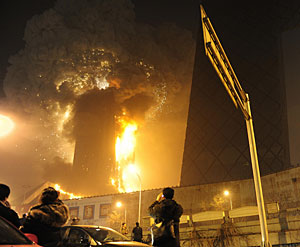A month after Beijing’s not-yet-occupied Television Cultural Center highrise was ignited by fireworks, leaving it a charred shell, new ideas about how the fire started and spread have arisen. Few are willing to speak on the record, but one developer unconnected to the project even proposed prohibiting fireworks in dense Beijing.

Illegal fireworks ignited the February 9 blaze.
The 31-story TVCC building was designed by Rem Koolhaas’ Office for Metropolitan Architecture and was scheduled to open in May. It is adjacent to the iconic headquarters of China Central Television (CCTV), also designed by OMA. The TVCC burned the night of February 9, the last night of the Chinese New Year’s celebration. One firefighter died from smoke inhalation.
Most of the blame for the fire is directed at the state-owned CCTV network. Beijing officials detained a total of 17 people, including the chief of construction, which CCTV admitted to hiring. The suspects reportedly set off high-explosive pyrotechnic devices at the site without receiving the necessary municipal approval.
The fireworks that allegedly ignited the fire have been categorized as “A grade,” which require trained personnel granted with special permission from the city. “The company did not listen to the police, who advised against setting off A-grade fireworks,” said Luo Yuan, spokesman and deputy chief of the Beijing Fire Control Bureau.
The fire resulted in damages greater than 4 billion yuan (US $588 billion), estimated China Free Press. As explained in Caijing, a Chinese financial magazine respected for its objectivity and independence, the TVCC tower is actually a composite of three structures: a main tower in the center that was to house a restaurant and 241-room, five-star hotel managed by the Mandarin Oriental, and two angular wings that branch off the tower. The wings were designed to host a theater, television studio, and an electronic data processing center.
Many questions remain about the speed with which the fire spread through the 31-floor, steel-framed building. How the fireworks penetrated the structure’s cladding also isn’t clear. The tower’s northern and southern facades are metal and glass, while the east and west sides feature metal strips.
According to Caijing, some firefighters suspect that two of the fireworks struck the tower’s south side, burning through the thin metal facade and sparking the flammable insulation layer underneath, which then carried the fire over the entire building. Yet Beijing’s Fire Brigade said the fire began on the building’s roof and spread to the lower floors, fed by high winds. And a CNN report posited, “there was a lot of debris on site, which ignited very quickly.”
Several architects who helped design the CCTV complex suggested a slightly different possibility: After visiting the site and surveying video and photos of the burning tower, they told Caijing that they “suspect the fireworks set flame to the tower’s exterior at several points. The flames continued from there to the insulation layer underneath, and then inside the building where interior decorations spread them further."
There is yet another theory: Heat transfer alone may have set fire to the building, said an architect who took part in the design of the TVCC. The reinforcing bars that cover the TVCC are metal and could have become superheated from the nearby explosions. If they became hot enough, said the architect, they could have kindled the insulation.
The fire’s speed may be due to chimney effects in the core. Once the fire broke out, the hollow core between the 5th and 26th floors of the TVCC may have accelerated the blaze. Moving air in this space would have provided the fire with ample oxygen, with pressure from the smoke, fire, and hot air building inside the core until finally it exploded, carrying the fire through the whole building in the blink of an eye. In fact, several explosions were seen and heard, according to reports from those who were on site. The Beijing Municipal Fire Bureau also confirmed that the TVCC’s core collapsed in the fire.
Because construction wasn’t yet completed and the sprinkler system was not installed, there was a long delay before the fire was suppressed. TVCC had followed all city building codes, according to Aaron DeWoskin, an architect at Huatong Design & Consulting Engineering, a company that focuses on registration and city ordinances for construction and engineering projects in Beijing.
As of right now, it does not appear that Beijing officials will ban firework displays. In fact, it was only a few years ago, in 2005, that Beijing lifted a ban on fireworks in the city center after a 12-year hiatus.
Pan Shiyi, chairman of the SoHo group and one of Beijing’s best-known developers, has been a vocal critic of firework displays in the city. He wrote on his blog: “In a city as big as Beijing, we really shouldn’t be allowed to set off fireworks.” Yet rather than blaming fireworks in general, the municipal government is focusing fact the fire was set by high-grade fireworks that were illegally set off.
OMA, Arup East Asia (the design and engineering firm that worked on the building), and Mandarin Oriental did not respond to calls or e-mails. But they all released statements and reportedly plan to announce further updates in the future. At this point, none has said whether the charred building will be torn down or renovated.
The building was scheduled to open mid-May and the hotel, which had been insured for 1.5 billion yuan (US $220 million), this summer. It is not immediately known whether the fire would postpone the official inauguration of the new CCTV tower, originally slated for October. Also unknown is the value of insurance payouts, which depend on the outcome of an ongoing investigation.


